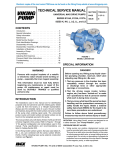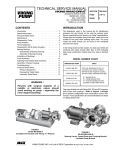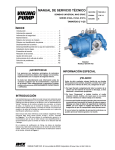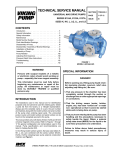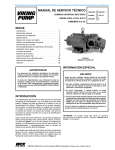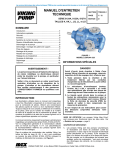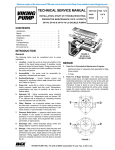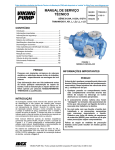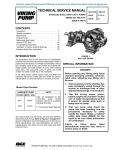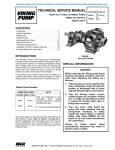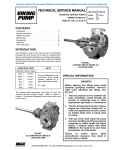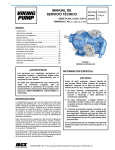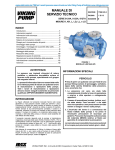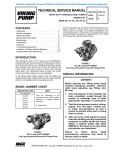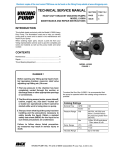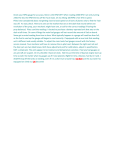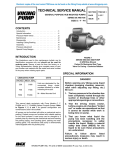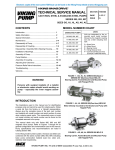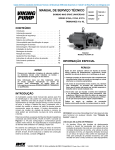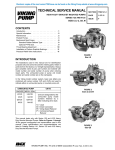Download TECHNICAL SERVICE MANUAL
Transcript
Electronic copies of the most current TSM issue can be found on the Viking Pump website at www.vikingpump.com TECHNICAL SERVICE MANUAL UNIVERSAL MAG DRIVE PUMPS SERIES 8124A, 8123A, 8127A SECTION TSM 635.3 PAGE 1 of 13 ISSUE C SIZES Q AND QS CONTENTS Introduction . . . . . . . . . . . . . . . . . . . . . . . . 1 Special Information . . . . . . . . . . . . . . . . . . . . 1 Safety Information . . . . . . . . . . . . . . . . . . . . . 2 Maintenance . . . . . . . . . . . . . . . . . . . . . . . 3 Model Number System . . . . . . . . . . . . . . . . . . 4 Parts Identification Drawings . . . . . . . . . . . . . . . 5 Disassembly of Pump . . . . . . . . . . . . . . . . . . . 5 Disassembly / Assembly of Bearing Housing . . . . . . . 7 Installation of Bushings . . . . . . . . . . . . . . . . . . 7 Assembly of Pump . . . . . . . . . . . . . . . . . . . . 8 Pump Rotation . . . . . . . . . . . . . . . . . . . . . .10 Adjusting End Clearance . . . . . . . . . . . . . . . . .10 Pressure Relief Valve Instructions . . . . . . . . . . . . 11 Troubleshooting . . . . . . . . . . . . . . . . . . . . . 12 Warranty . . . . . . . . . . . . . . . . . . . . . . . . .13 WARNING! Persons with surgical implants of a metallic or electronic nature should avoid working on pump – especially the magnet assembly. This information must be read fully before beginning any maintenance or repair of the pump. All maintenance or repair must be done by SUITABLY TRAINED or qualified persons only. INTRODUCTION The illustrations used in this manual are for identification purposes only and cannot be used for ordering parts. Obtain a parts list from the factory or a Viking® representative. Always give the complete name of a part, the part number and material, along with the model number and serial number of the pump when ordering repair parts. The unmounted pump or pump unit model number and serial number can be found on the nameplate secured to the pump. This manual refers only with Series 8124A, 8123A and 8127A universal magnetic drive pumps. Refer to Figures 1 through 19 for general configuration and nomenclature used in this manual. Pump specifications and recommendations are listed in Catalog Section 635. In the Viking model number system, the basic size letters (Q and QS) are combined with the series number (8124A, 8123A, 8127A) indicating basic pump external construction material, see Figure 4. FIGURE 1 Model Q8124A-425 SPECIAL INFORMATION DANGER ! Before opening any Viking pump liquid chamber (pumping chamber, reservoir, relief valve adjusting cap fitting etc.) Be sure: 1.That any pressure in the chamber has been completely vented through the suction or discharge lines or other appropriate openings or connections. 2. That the driving means (motor, turbine, engine, etc.) has been “locked out” or made non- operational so that it cannot be started while work is being done on pump. 3.That you know what liquid the pump has been handling and the precautions necessary to safely handle the liquid. Obtain a material safety data sheet (MSDS) for the liquid to be sure these precautions are understood. Failure to follow above listed precautionary measures may result in serious injury or death. VIKING PUMP, INC. • A Unit of IDEX Corporation • Cedar Falls, IA 50613 USA SAFETY INFORMATION AND INSTRUCTIONS IMPROPER INSTALLATION, OPERATION OR MAINTENANCE OF PUMP MAY CAUSE SERIOUS INJURY OR DEATH AND/OR RESULT IN DAMAGE TO PUMP AND/OR OTHER EQUIPMENT. VIKING’S WARRANTY DOES NOT COVER FAILURE DUE TO IMPROPER INSTALLATION, OPERATION OR MAINTENANCE. THIS INFORMATION MUST BE FULLY READ BEFORE BEGINNING INSTALLATION, OPERATION OR MAINTENANCE OF PUMP AND MUST BE KEPT WITH PUMP. PUMP MUST BE INSTALLED, OPERATED AND MAINTAINED ONLY BY SUITABLY TRAINED AND QUALIFIED PERSONS. THE FOLLOWING SAFETY INSTRUCTIONS MUST BE FOLLOWED AND ADHERED TO AT ALL TIMES. Symbol Legend : ! Danger - Failure to follow the indicated instruction may result in serious injury or death. BEFORE opening any liquid chamber (pumping chamber, reservoir, relief valve adjusting cap fitting, etc.) be sure that : ! ● Any pressure in the chamber has been completely vented through the suction or discharge lines or other appropriate openings or connections. ● The pump drive system means (motor, turbine, engine, etc.) has been “locked out” or otherwise been made non-operational so that it cannot be started while work is being done on the pump. WARNING WARNING ! WARNING ● You know what material the pump has been handling, have obtained a material safety data sheet (MSDS) for the material, and understand and follow all precautions appropriate for the safe handling of the material. BEFORE operating the pump, be sure all drive guards are in place. ! DO NOT operate pump if the suction or discharge piping is not connected. ! ! ! DO NOT place fingers into the pumping chamber or its connection ports or into any part of the drive train if there is any possibility of the pump shafts being rotated. ! ! WARNING DO NOT exceed the pumps rated pressure, speed, and temperature, or change the system/duty parameters from those the pump was originally supplied, without confirming its suitability for the new service. ! WARNING BEFORE operating the pump, be sure that: ! ● It is clean and free from debris WARNING ● all valves in the suction and discharge pipelines are fully opened. ● All piping connected to the pump is fully supported and correctly aligned with the pump. ● Pump rotation is correct for the desired direction of flow. ! WARNING SECTION TSM 635.3 ISSUE C PAGE 2 OF 13 Warning - In addition to possible serious injury or death, failure to follow the indicated instruction may cause damage to pump and/or other equipment. INSTALL pressure gauges/sensors next to the pump suction and discharge connections to monitor pressures. USE extreme caution when lifting the pump. Suitable lifting devices should be used when appropriate. Lifting eyes installed on the pump must be used only to lift the pump, not the pump with drive and/or base plate. If the pump is mounted on a base plate, the base plate must be used for all lifting purposes. If slings are used for lifting, they must be safely and securely attached. For weight of the pump alone (which does not include the drive and/or base plate) refer to the Viking Pump product catalog. DO NOT attempt to dismantle a pressure relief valve that has not had the spring pressure relieved or is mounted on a pump that is operating. AVOID contact with hot areas of the pump and/or drive. Certain operating conditions, temperature control devices (jackets, heat-tracing, etc.), improper installation, improper operation, and improper maintenance can all cause high temperatures on the pump and/or drive. THE PUMP must be provided with pressure protection. This may be provided through a relief valve mounted directly on the pump, an in-line pressure relief valve, a torque limiting device, or a rupture disk. If pump rotation may be reversed during operation, pressure protection must be provided on both sides of pump. Relief valve adjusting screw caps must always point towards suction side of the pump. If pump rotation is reversed, position of the relief valve must be changed. Pressure relief valves cannot be used to control pump flow or regulate discharge pressure. For additional information, refer to Viking Pump’s Technical Service Manual TSM 000 and Engineering Service Bulletin ESB-31. THE PUMP must be installed in a matter that allows safe access for routine maintenance and for inspection during operation to check for leakage and monitor pump operation. ROTATION: Viking Mag Drive® pumps are designed to run in either direction. See “Pump Rotation”, page 10. PRESSURE RELIEF VALVES: CLEANING PUMP: Keep the pump as clean as possible. This will facilitate inspection, adjustment and repair work. 1. Viking pumps are positive displacement pumps and must be provided with some sort of pressure protection. This may be a relief valve mounted directly on the pump, an inline pressure relief valve, a torque limiting device or a rupture disk. Do not rely on decoupling of magnets for protection from over pressure; this may result in damage to the magnets, pump, or other equipment. LUBRICATION: 2. Relief valves are mounted as standard on the casing of all pumps. STORAGE: 3. If the pump rotation is to be reversed during operation, pressure protection must be provided on both sides of the pump. 4. The relief valve adjusting screw cap must always point towards the suction side of the pump, see Figure 2. If the pump rotation is reversed, remove the pressure relief valve and turn end for end (see “Pump Rotation”, page 10). 5. Pressure relief valves cannot be used to control pump flow or regulate discharge pressure. For additional information on pressure relief valves, refer to Technical Service Manual TSM000 and Engineering Service Bulletin ESB-31. Bracket bearings require external lubrication. This must be applied slowly with a handgun to lubrication fittings every 500 hours of operation with multi-purpose grease, NLGI # 2. Do not over-grease. Applications involving very high or low temperatures will require other types of lubrication. Refer to ESB-515. Consult factory with specific lubrication questions. If the pump is to be stored, drain and pour non-detergent SAE 30-weight oil (or compatible alternative) into the pump port. Apply grease to the pump shaft, if accessible. Viking suggests rotating the pump shaft every 30 days to circulate the oil in the pump. The pump should be stored in a dry area. SUGGESTED REPAIR TOOLS: The following tools are required to properly repair series 8124A, 8123A and 8127A pumps. These tools are in addition to standard mechanics’ tools such as open-end wrenches, pliers, screwdrivers, etc. Most of the items can be obtained from an industrial supply house. 1. Soft face hammer 2. Allen wrench set (SAE) 3. Torque wrench with a locknut socket CAUTION ! Rare earth magnets used in couplings have extremely strong magnetic fields capable of changing performance or damaging items such as the following: Pacemakers Metal Implants Watches Computers & disks Credit Cards 4. Two feeler gauge sets 5. Arbor press 6. Brass bar 7. Hook style spanner wrench 8. Canister Sleeve (3-810-025-999-00) 9. Inner Magnet Lift (3-810-026-999-00) 10. Bearing Housing Lift (Figures 3 and 9) DISCHARGE SUCTION RELIEF VALVE ADJUSTING SCREW CAP Figure 2 Relief Valve Position MAINTENANCE Series 8124A, 8123A and 8127A pumps are designed for long, trouble-free service life under a wide variety of application conditions with a minimum of maintenance. The points listed below will help provide long service life. NOTES: 1. Material must conform to ASTM A36 2. Dimensions are in inches 3. Tolerances are ± .02 4. Thickness is .25 Figure 3 Bearing housing lift SECTION TSM 635.3 ISSUE C PAGE 3 OF 13 Field 1 Field 2 Field 3 Field 4 Field 5 Field 6 Field 7 Field 8 Field 9 QS8124A - 4 2 5 R Size: Q QS Shaft Sealing: 8 = Sealless Series Edition: A = Original Design Jacketing: 1 = Non-Jacketed Bracket Material of Construction: 3 = Steel Externals 4 = Cast Iron 7 = Stainless Steel Drive Configurations: __ = Standard Pump D = Direct Drive R = Reducer Drive P = Purchased Reducer Torque Specifications: Q-QS = 425 Ft-lb Q-QS = 900 Ft-lb Figure 4 Model number system Adaptor Plate Outer Magnet Assembly Thrust Washers Inner Magnet Assembly Rotor and Shaft Canister and Bushing Assembly Tapered Roller Bearings Internal Relief Valve Bearing Housing Casing Shaft Bushing Bracket Figure 5 Cutaway View of universal Mag Drive Pump SECTION TSM 635.3 ISSUE C PAGE 4 OF 13 54 59 65 13 57 66 60A 60 67 33 31 62 60 36 37 38 35 63 39 40 60A 25 43 45 47 46 44 52 51 ITEM NAME OF PART ITEM NAME OF PART ITEM 13 Capscrews for Adaptor Plate (8-Req’d) 40 Head and Idler Pin Assembly 57 Inner Magnet Assembly 25 Adaptor Plate Bushing 43 Studs for Head (8-Req’d) 59 Canister 31 Casing 44 Nuts for Head (8-Req’d) 60 Thrust Washer - Rotating (2-Req’d) 33 Adaptor Plate O-Ring 45 Relief Valve Gaskets (2-Req’d) 35 Head O-Ring 46 Capscrews for Relief Valve (8-Req’d) 62 Key for Rotor Shaft 36 Rotor and Shaft Assembly 47 Relief Valve 63 Shims for Head 37 Idler and Bushing Assembly 51 Studs for Flanges (16-Req’d) 65 Canister O-Ring 38 Idler Bushing 52 Nuts for Flanges (16-Req’d) 66 Split Locknut 39 Idler Pin 54 Capscrews for Canister (8-Req’d) 67 Adaptor Plate 60A NAME OF PART Thrust Washer - Stationary (2-Req’d) Figure 6 Exploded View – universal mag drive pump canister through relief valve 14 1 4 6 2 ITEM NAME OF PART 5 ITEM 8 7A 12 7 28 28A 27 5 3 58 6 NAME OF PART ITEM NAME OF PART 1 Locknut 6 Tapered Roller Bearing (2-Req’d) 14 Capscrews for Disassembly (3-Req’d) 2 Lockwasher 7 Bearing Housing 27 Bracket 3 End Cap 28 Capscrews for Mounting Bracket (2-Req’d) 4 Outer Bearing Spacer 8 Inner Bearing Spacer 5 Lipseal (2-Req’d) 12 Grease Fitting 7A Capscrews for Bearing Housing (6-Req’d) 28A 58 Capscrews for Bracket (2-Req’d) Outer Magnet Assembly Figure 7 Exploded View – Universal mag drive pump bracket and outer magnet assembly PUMP DISASSEMBLY WARNING! Refer to DANGER & CAUTION listed on page 2 before proceeding. NOTE: Some steps require a second person for ease of disassembly. 1. Drain the liquid being pumped by removing the two drain plugs (if present). Both are located in the bottom of the casing. Once the liquid has drained, replace the plugs. 2. Refer to Figures 6 and 7 for the names of parts. 3. Use a non-magnetic surface to disassemble the pump. 4. Mark the head (40) and casing (31) before disassembly to insure proper reassembly. 5. To inspect the head and pin assembly (39 and 40) and idler and bushing assembly (37 and 38), remove the head nuts (44). 6. Remove the head from the pump. Tilt the top of the pump head back during removal to prevent the idler from falling off the idler pin. If the casing was not drained in Step 1, be careful of the liquid draining out between the head and casing. Avoid damaging the head shim set (63) since all shims are required to maintain end clearance. Inspect the O-ring (35). Do not remove the O-ring from the plate adaptor / casing SECTION TSM 635.3 ISSUE C PAGE 5 OF 13 unless it is damaged, especially if it is PTFE (derivative) encapsulated. If a new O-ring is required, See “Pump Assembly” on page 8. 7. Remove the idler and bushing assembly. Inspect the idler bushing for wear. If the idler bushing needs to be replaced, see “Installation of Bushings” on page 7. If further disassembly is required, proceed to the next step. 8. If further disassembly is required, separate the pump from the motor. Remove the six hex head capscrews (7A) securing the bearing housing to the bracket. Support the bearing housing with an overhead hoist using a tool. See Figure 9 dimensions for tool on page 3. Do not use tool to lift pump, use eyebolt on bracket. 9. Use the jackscrews (14) in the bearing housing to separate the inner magnet (57) from the outer magnet (58), see sequence in Figure 8. To keep the bearing housing and bracket assemblies properly aligned and for additional safety, it is recommended to use 2 lengths of all-thread rod (12”) threaded into opposite capscrew locations in the bracket and slide through the corresponding holes in the bearing housing. 10. Slide the outer magnet assembly out of the bracket (27). Visually inspect the outer magnets. Inspect the magnet assembly for damage or wear; replace if needed. If further disassembly of the bearing housing is required, see “Disassembly / Assembly of Bearing Housing”, page 7. 11. Place the canister sleeve (3-810-025-999-00) into the bracket over the canister (59). Remove the socket head capscrews (28 & 28A) securing the bracket to the pump. Support the pump with an overhead hoist and fixture that is in-line with the center of gravity of the pump. Slide the pump out of the bracket. 12. Remove the canister sleeve. Remove the socket head capscrews (54) from the canister. If the canister was not drained in Step 1, it will contain liquid. Use care when removing the canister from the pump by pulling it straight off. Inspect the canister bushing (64) for wear. If the canister bushing needs to be replaced, see “Installation of Bushings” on page 7. do not place fingers here CAPSCREW do not place fingers here do not place fingers here all-thread rod Figure 8 PUMP SEPARATION SEQUENCE 13. Inspect the O-ring (65). Do not remove the O-ring from the plate adaptor (67) / canister unless it is damaged, especially if it is PTFE encapsulated. If a new O-ring is required, See “Pump Assembly” on page 8. 14. Insert a brass bar into the rotor (36) through a port between two rotor teeth and remove the split locknut (66), see Figure 10. Support the inner magnet using inner magnet lift (3-810-026-999-00). Do not forget this is a very strong magnet. Slide the inner magnet assembly off of the shaft. Make sure the thrust washer (60) does not fall off the inner magnet assembly. Place inner magnet on non-magnetic cradle similar to Figure 11. Inspect the magnet assembly for damage or wear; replace if needed. If further disassembly is required, proceed to the next step. setscrew 15. Remove the shaft key from the rotor shaft. Remove the thrust washer (60A) from the adaptor plate if worn or cracked. The rotor and shaft may now be removed by tapping on the end of the shaft with a soft face hammer (If a soft face hammer is not available, a regular hammer may be used with a piece of hardwood). Take locknut SECTION TSM 635.3 ISSUE C PAGE 6 OF 13 Figure 9 inner magnet assembly FigurE 10 INNER MAGNET AND LOCKNUT ASSEMBLY care that the thrust washer on the rotor does not come off. Remove the thrust washer from behind the rotor if worn, cracked or the rotor and shaft is being replaced. Remove and check the casing side adaptor plate thrust washer for cracks or wear; replace if necessary. 16. Inspect the adaptor plate bushing (25). If the bushing needs to be replaced, see “Installation of Bushings” on page 7. If the pump is leaking between adaptor plate and casing (31), remove the socket head capscrews (13) from the adaptor plate. Slide the adaptor plate out of the casing. 17.Inspect the O-ring (33). Do not remove the O-ring from the plate adaptor / casing unless it is damaged, especially if it is PTFE encapsulated. If a new O-ring is required, See “Pump Assembly” on page 8. Slide the outer bearing spacer collar onto the shaft and into the outer lipseal, followed by the lockwasher and locknut. 6. Tighten the locknut to 170-190 ft-lbs of torque and then bend over the appropriate lockwasher tab. 7. Unscrew the end cap (counterclockwise) by hand until there is considerable drag on the bearings. Mark the end cap and bracket in the same spot. Then screw in the end cap (clockwise) 5/16”, radially from the mark. Tighten the end cap setscrews. 8. Grease the bracket using the bracket fitting with NLGI #2 grease. Make sure the shaft freely rotates by hand. 18.Inspect the casing for wear, particularly in the area between the ports. Clean all other parts thoroughly and examine for wear or damage. Figure 11 When making major repairs, such as replacing a rotor and shaft, it is advisable to also install a new head and idler pin, idler and bushing, and adaptor plate bushing. See “Installation of Bushings” on page 7. DISASSEMBLY / ASSEMBLY OF BEARING HOUSING DISASSEMBLY The bearing carrier assembly features two tapered roller bearings, two lipseals, and one spacer. If further disassembly of this unit is required, proceed as follows: 1. Remove locknut (1) and washer (2). tapered roller BEARINGs 2. Loosen the setscrews holding the end cap (3) in the bracket. Screw the end cap out of the bracket. 3. Inspect the bearings (6) for wear; replace as needed. 4. Inspect the lipseals (5) for wear; replace as needed. The lipseals will need to be replaced if removed. 5. If the bearings are worn it is recommended to replace the entire bearing. Remove the inner bearing spacer collar (8). Press the inner bearing cup out of the bearing housing and the outer bearing cup out of the end cap. The bearings will need to be replaced if the cups are removed. ASSEMBLY 1. If the bearing cups were removed, press the cup of the outer bearing into the end cap. Press the cup of the inner bearing into the bearing housing. 2. Press the inner lipseal into the bearing housing and the outer lipseal into the end cap and then lubricate the lipseals, see Figure 12 for lipseal and bearing orientation. 3. Screw the end cap into the bearing housing (clockwise) until it contacts. Do not over-tighten the end cap. 4. Inspect the outer magnet to make sure it has not picked up any foreign particles, which could damage the pump. Slide the inner roller bearing onto the shaft, followed by the inner bearing spacer. 5. Slide the outer magnet assembly into the bearing housing. Slide the outer roller bearing onto the shaft. lipseals Figure 12 BRACKET BEARING AND LIPSEAL ORIENTATION INSTALLATION OF BUSHINGS CARBON GRAPHITE If attempting to install the carbon graphite idler, canister or adaptor plate bushings, extreme care must be taken to prevent breaking. Carbon graphite is a brittle material and easily cracked. If cracked, the bushing will quickly disintegrate. Using a lubricant on the bushing and mating part will help facilitate installation. ADAPTOR PLATE: The groove in the ID of the bushing should line up with the groove in the adaptor plate. Figure 14 on page 8 shows the proper position of the adaptor plate bushing after installation. SECTION TSM 635.3 ISSUE C PAGE 7 OF 13 CANISTER: Figure 13 shows the proper orientation of the canister bushing after installation. Bushing should be flush with or up to 0.010” below bushing hub face. Be certain canister is properly supported. LUBE GROOVES CANISTER Figure 13 BUSHING BUSHINGS: Installing bushings may require a special fixture to ensure proper positioning. Improper location may result in a pump with excessive slip, pre-mature wear or requiring a large number of shims. The additional precautions listed below must be followed for installation: 1. An arbor press must be used for the installation. 2. Be certain the bushing is started straight. 3. Do not stop the pressing operation until the bushing is in the proper position; starting and stopping will result in a cracked bushing. 4. After installation, check the bushing for cracks. adaptor plate casing bushing INCH MM .000 0.000 -.005 -0.127 Figure 14 ADAPTOR PLATE BUSHING POSITION PUMP ASSEMBLY DANGER ! Follow these directions exactly to avoid injury to self or damage to the pumping unit. Be careful to keep the inner and outer magnets at least (1) foot apart until step 17. Do not engage the magnets in any other fashion. SECTION TSM 635.3 ISSUE C PAGE 8 OF 13 CAUTION ! Do not place fingers onto the front of pump mounting flange. Align the canister into bore of the bracket and gently slide it in. When the magnets start to engage, the unit will finish engagement on its own very rapidly unless the 5/8” x 6” capscrew is properly used. Make sure fingers are not on the front of the pump. See Sequence in Figure 18. DANGER! Be certain that the driving means (motor, turbine, engine, etc.) has been “locked out” or made non-operational so that it cannot be started while work is being done on pump. NOTE: Some steps require a second person for ease of assembly. Use a suitable lubricant compatible with the fluid being handled when reassembling the pump. Inspect all parts, especially drilled holes in the casing (for draining) to make sure they are not plugged. Replace any worn parts, remove any burrs and clean all parts before assembling the pump. Use a non-magnetic surface to assemble the pump. 1. If the adaptor plate O-ring on the casing side needs to be replaced, apply a lubricant to the O-ring and place it onto the casing side of the adaptor plate. If the O-ring is PTFE (derivative) encapsulated, follow these special instructions. Do not attempt to reuse this type of O-ring if it has been removed. Immerse a new O-ring in boiling water for a few minutes. Remove it from the water and stretch out the O-ring. This ensures it will fit into the plate or groove without forcing the O-ring over a sharp edge. Run hot water over the O-ring until it shrinks down tight. Hot water makes the PTFE pliable and allows the inner elastomer to pull the PTFE back to the original size. Dry it with compressed air. 2. Position the adaptor plate so the adaptor plate groove aligns to groove in the casing bore at suction port, see Figure 15. Carefully slide the adaptor plate into the bracket side of the casing. Use care to prevent cutting the O-ring with the edge of the adaptor plate or casing. Secure into position by tightening the eight capscrews. 3. Apply lubricant to the ID of the adaptor plate bushing. Clean the rotor and shaft so it is free of dirt, grit and other debris. Remove burrs around the keyway and shoulder of the shaft. 4. Apply a light oil to the first set of thrust washers on the side of the thrust washer that will touch the rotor or adaptor plate. Place the thrust washer that does not have a groove onto the shaft so that the blind holes in the thrust washer will line up with the drive pins on the back of the rotor. Place the thrust washer with a groove onto the adaptor plate so that the groove in the thrust washer will line up with the grooves in the adaptor plate, see Figure 15. feeler gauges DISCHARGE PORT thrust washer SUCTION PORT ADAPTOR PLATE GROOVE SUCTION PORT VIEWED FROM HEAD END Figure 16 SETTING THRUST WASHER CLEARANCE DISCHARGE PORT ADAPTOR PLATE GROOVE Figure 15 ADAPTOR PLATE / cASING pOSITIONING (Q SIZE SHOWN) 5. Having a second person on the opposite side of the casing will help in placing the rotor and shaft into the pump and prevent damage to the adaptor plate bushing. Have the second person support the shaft through the hollow shaft. Slide the shaft into the adaptor plate bushing until the thrust washers come in contact. Make sure that the thrust washers remain seated on the drive pins and flat against the rotor or adaptor plate. 6. Apply a light oil to the second set of thrust washers on the side of the thrust washer that will touch the inner magnet or adaptor plate. Slide the thrust washer with a groove over the shaft into the adaptor plate (bracket side), groove facing out. Then install the key into the shaft. 7. Clean the face on the inner magnet that faces the adaptor plate. Place the second thrust washer that does not have a groove onto the inner magnet so that the blind holes in the thrust washer will line up with the drive pins on the inner magnet. Support the inner magnet using the inner magnet lift. Slide the inner magnet onto the shaft until the thrust washers are almost touching. Apply anti-seize compound to the threads of the split locknut and install with the raised face towards the inner magnet, do not tighten completely. 8. Place two feeler gauges (0.003”), one on each side of the shaft, between the adaptor plate thrust washer and the inner magnet thrust washer. Refer to Figure 16. This will establish the proper clearance for the thrust washers. Tighten the locknut until the feeler gauges are snug, but can still be removed. Do NOT remove the feeler gauges at this time. 9. Tighten the setscrew in the locknut. Check the feeler gauges. If the gauges are too tight, loosen the setscrew and locknut slightly and repeat tightening procedure. Remove the feeler gauges. Check to make sure the pump rotates freely by turning the inner magnet assembly. 10. If the old shims are not reusable or if any parts have been replaced, operating clearances will need to be re-established. Refer to “Adjusting End Clearance” on page 10. Otherwise, place the head shims on the head. There is an offset hole in the head, casing and shims. These parts will only fit together one way. There is a notch in the shims to indicate the offset hole. The proper amount of shims should be used to provide the correct end clearance (0.010” for sizes Q and QS). Inspect the head o-ring; replace if needed. Refer to Step 1 if PTFE (derivative) encapsulated. Lubricate the O-ring and place on the head. 11. Ensure pipe plug is installed in the hole on the suction side of the head, at the base of the idler pin. Ensure the hole in the discharge side is unobstructed. See Figure 17 on page 10. 12. Coat the ID of the idler bushing with a suitable lubricant and place the idler on the idler pin in the head. 13. The head can now be assembled onto the pump. Tilt the top of the pump head away from the pump slightly until the crescent enters the inside diameter of the rotor and rotate the idler until its teeth mesh with the rotor teeth. Secure the head to the casing using eight nuts. Check the end clearance. Refer to “Adjusting End Clearance” on page 10, if needed. Rotate the shaft by hand to make sure it turns freely. The pump head and casing should have been marked before disassembly to insure proper reassembly. If not, be sure the idler pin, which is offset in the pump head, is placed between the port connections to allow for proper flow of liquid through the pump. 14. Inspect the magnet to make sure it has not picked up any foreign particles, which could damage the pump. Inspect the canister bushing; replace if needed. See “Installation of Bushings” on page 7. Lubricate the ID of the canister bushing. Inspect the canister o-ring; replace if needed. Refer to Step 1 if PTFE encapsulated. Lubricate and place the o-ring into the groove in the adaptor plate. Align the roll pin in the adaptor plate with the corresponding hole in the canister and place the canister onto the shaft. Secure the canister using eight capscrews. Be careful placing the setscrews as this is a strong magnet. Do not place fingers between magnet and capscrews. 15. Secure the bracket to a base or other stable platform. Inspect the canister to make sure it has not picked up SECTION TSM 635.3 ISSUE C PAGE 9 OF 13 any foreign particles, which could damage the pump. Place the canister sleeve onto the canister. Support the pump with an overhead hoist and fixture while guiding the canister into the bracket opening. Secure the pump to the bracket using four socket head capscrews. This figure is for illustrative purposes only. Actual pump construction and location of ports varies. SUCTION port 16.Inspect the bearing housing bearings and lipseals; replace if needed. Refer to “Disassembly / Assembly of Bearing Housing”, page 7. Inspect the outer magnet for any steel objects, which may be attached. Remove any foreign material. 17. Insert three fully threaded 5/8” X 6” hex head capscrews into the bearing housing until they are fully extended in front of the bearing housing to control assembling the pump, see Figure 18. To keep the bearing housing and bracket assemblies properly aligned and for additional safety, it is recommended to use 2 lengths of all-thread rod (12”) threaded into opposite capscrew locations in the bracket and slide through the corresponding holes in the bearing housing. 18. Back the capscrews off, being careful that the end of the capscrew is positioned in the counterbore hole of the bracket. Secure the bearing housing to the bracket plug with six capscrews. Make certain that the power supply to the pump is “Locked-out”. Check that the pump rotates freely by spinning the motor fan blades or pump shaft. PUMP ROTATION DISCHARGE port Figure 17 CIRCULATION OF LIQUID THROUGH UNIVERSAL MAG DRIVE PUMP Process fluid is generally fed to the hollow shaft and idler pin from the discharge side of the pump. Fluid is pushed into the canister bushing and around the inside of the canister. Then the fluid flows through the thrust washers and adaptor plate bushing interface back to the suction side of the pump. When the pump is operated in the opposite direction, the fluid flow is reversed, see Figure 17. ADJUSTING END CLEARANCE do not place fingers here all-thread rod do not place fingers here Standard end clearance of 0.010” is used on sizes Q and QS. End Clearances are adequate for viscosities up to 2500 SSU / 540 cSt (SAE 40 lube oil at room temperature). Higher viscosities require additional clearances. As a general rule, the end clearance is doubled for higher viscosities. For specific recommendations on end clearance for high viscosity or for operating temperatures above 225°F (107°C), check with your Viking representative or consult the factory. Use either of the following procedures to properly adjust the end clearance when replacing shims or reassembling the pump. PROCEDURE A: After the rotor has been installed and the locknut has been positioned and retained, insert a feeler gage of the proper end clearance into the port and between two rotor teeth, see Figure 19. With the idler on the idler pin, place the head into the pump casing. With the capscrews tight, the feeler gage should fit snugly; otherwise shims should be added or reduced in thickness until the proper clearance is attained. do not place fingers here CAPSCREW Figure 18 PUMP ASSEMBLY SEQUENCE SECTION TSM 635.3 ISSUE C PAGE 10 OF 13 Figure 19 PROCEDURE A PROCEDURE B: If the pump is in line and ports are not accessible, remove the head and shims. Put the head back on (without shims) and measure the gap as shown, see Figure 20. After determining the gap between the head and casing, select a combination of shims equal to the measured gap plus the desired end clearance. Remove head, install shims then install head. Tighten the head capscrews and check the pump clearance by making sure the pump turns freely by hand. DISASSEMBLY – RELIEF VALVE Mark the valve and head before disassembly to insure proper reassembly. 1. Remove the valve cap. 2. Measure and record the length of extension of the adjusting screw. Refer to “A” on Figure 21. 3. Loosen the locknut and back out the adjusting screw until spring pressure is released. 4. Remove the bonnet, spring guide, spring and poppet from the valve body. Clean and inspect all parts for wear or damage and replace as necessary. feeler gauge casing head VALVE - LIST OF PARTS Figure 20 PROCEDURE B PRESSURE RELIEF VALVE INSTRUCTIONS DANGER ! Before opening any Viking pump liquid chamber (pumping chamber, reservoir, relief valve adjusting cap fitting etc.) Be sure: 1.That any pressure in chamber has been completely vented through suction or discharge lines or other appropriate openings or connections. 1. Valve Cap 6. Valve Body 2. Adjusting Screw 7. Valve Spring 3. Lock Nut 8. Poppet 4. Spring Guide 9. Cap Gasket 5. Bonnet 10. Bonnet Gasket Figure 21 VALVE – Q and QS SIZES ASSEMBLY – RELIEF VALVE Reverse the procedures outlined under DISASSEMBLY – RELIEF VALVE. If the valve is removed for repairs, be sure to replace in the original position. The relief valve adjusting screw cap must always point towards the suction side of the pump. If the pump rotation is reversed, remove the relief valve and turn end for end. Refer to Figure 2, page 3. 2.That the driving means (motor, turbine, engine, etc.) has been “locked out” or made non- operational so that it cannot be started while work is being done on pump. 3. That you know what liquid the pump has been handling and the precautions necessary to safely handle the liquid. Obtain a material safety data sheet (MSDS) for the liquid to be sure these precautions are understood. Failure to follow above listed precautionary measures may result in serious injury or death. SECTION TSM 635.3 ISSUE C PAGE 11 OF 13 DANGER! Before starting pump, be sure all drive equipment guards are in place. Failure to properly mount guards may result in serious injury or death. PRESSURE ADJUSTMENT If a new spring is installed or if the pressure setting of the pressure relief valve is to be changed from that which the factory has set, the following instructions must be carefully followed. 1. Carefully remove the valve cap, which covers the adjusting screw. 2. Loosen the locknut, which locks the adjusting screw so pressure setting will not change during operation of pump. 3. Install a pressure gauge in the discharge line for the actual adjustment operation. 4. Turn the adjusting screw in to increase pressure and out to decrease pressure. 5. With discharge line closed (less than one minute at a time to prevent damage to pump) at a point beyond the pressure gauge, gauge will show the maximum pressure valve will allow while the pump is in operation. IMPORTANT When ordering parts for the pressure relief valve, always give the model number and serial number of the pump as it appears on nameplate and name of the part wanted. When ordering springs, be sure to give pressure setting desired. TROUBLESHOOTING Some of the following may help pinpoint the problem: Pump does not pump: • Pump has lost its prime from air leak or low level in tank. • Suction lift is too high. • Pump is rotating in the wrong direction. • The strainer may be clogged. • The bypass valve is open, the pressure relief valve is set too low or the pressure relief valve poppet is stuck open. • Improper end clearance. • The pump is worn out. • Are there any changes in liquid, system or operation that would influence pump or coupling performance, e.g. new liquid, additional lines or process changes? • Temperature changes either in the liquid or the environment. • The magnetic coupling is decoupling. Changes in application (temperature, pressure, viscosity, etc.) may require torque beyond coupling capabilities. SECTION TSM 635.3 ISSUE C PAGE 12 OF 13 Pump starts, then loses its prime: • The supply tank is empty. • Liquid is vaporizing in the suction line. • An air leak or air pocket in the suction line. Pump is noisy: • The pump is being starved (viscous liquid cannot get to pump fast enough). Increase the suction pipe size, reduce its length or slow down the pump. • The pump is cavitating (liquid vaporizing in suction line). Increase suction pipe size or reduce its length. • Check alignment. • The magnetic coupling has decoupled. Shut off and let cool, then restart. Pump is not delivering up to capacity: • The pump is starving or cavitating - increase suction pipe size or reduce length or reduce pump speed. • The strainer is partially clogged. • An air leak somewhere in suction line. • The pump may be running too slow. Is the motor at the correct speed and wired up correctly? • The pressure relief valve is set too low, stuck open or has a damaged poppet or seat. • The bypass line around the pump is partially open. • The pump is worn out or there is too much end clearance. Pump takes too much power (stalls motor): • The liquid is more viscous than the unit is sized to handle. • The system pressure relief valve is set too high. • The bushings have frozen up or the liquid has set up in the pump. TECHNICAL SERVICE MANUAL UNIVERSAL MAG DRIVE PUMPS SERIES 8124A, 8123A, 8127A SECTION TSM 635.3 PAGE 13 of 13 ISSUE C SIZES Q AND QS CAUTION ! TO REDUCE THE RISK OF LEAKAGE WITH VIKING MAG DRIVE PUMPS, USERS SHOULD COMPLY WITH THE FOLLOWING GUIDELINES AND ADHERE TO THE FOLLOWING PROCEDURES: ■ The pump configuration and materials used in a pump are tailored to the application for which it is ordered. Users should never use a pump for an application that is different from the application specified when the pump was ordered. This includes differences in liquid, speed, pressure, temperature or viscosity. ■ Users must understand the characteristics of liquids they are pumping and be especially aware of any particulates in the liquid. Particulates can cause rapid wear of the bushings, especially if carbon graphite bushings are used. Hard bushings and hard shafts can reduce the risk of rapid wear, but the use of hard materials is not always the optimal solution. In applications involving non-abrasive, nonself lubricating liquids, carbon graphite bushings are typically the preferred material. ■ Users should periodically inspect their pump for wear. This is especially critical and should be carried out with greater frequency when carbon graphite bushings are used or the same pump has not previously been used for the same application, including the same liquid, speed, pressure, temperature and viscosity. Users should promptly replace worn parts when they are discovered. ■ Users should continuously monitor pumps that are handling hazardous liquids. This is especially critical for unmanned, remote locations. If a user does not have in-house expertise in the area of monitoring, it should contact a local engineering firm with monitoring experience. WARRANTY Viking warrants all products manufactured by it to be free from defects in workmanship or material for a period of one (1) year from date of startup, provided that in no event shall this warranty extend more than eighteen (18) months from the date of shipment from Viking. The warranty period for Universal Seal series pumps ONLY (Universal Seal models listed below) is three (3) years from date of startup, provided that in no event shall this warranty extend more than forty-two (42) months from the date of shipment from Viking. UNDER NO CIRCUMSTANCES SHALL VIKING BE LIABLE UNDER THIS WARRANTY OR OTHERWISE FOR SPECIAL, INCIDENTAL, INDIRECT, CONSEQUENTIAL OR PUNITIVE DAMAGES OF ANY KIND, INCLUDING, BUT NOT LIMITED TO, LOST OR UNREALIZED SALES, REVENUES, PROFITS, INCOME, COST SAVINGS OR BUSINESS, LOST OR UNREALIZED CONTRACTS, LOSS OF GOODWILL, DAMAGE TO REPUTATION, LOSS OF PROPERTY, LOSS OF INFORMATION OR DATA, LOSS OF PRODUCTION, DOWNTIME, OR INCREASED COSTS, IN CONNECTION WITH ANY PRODUCT, EVEN IF VIKING HAS BEEN ADVISED OR PLACED ON NOTICE OF THE POSSIBILITY OF SUCH DAMAGES AND NOTWITHSTANDING THE FAILURE OF ANY ESSENTIAL PURPOSE OF ANY PRODUCT. THIS WARRANTY IS AND SHALL BE VIKING’S SOLE AND EXCLUSIVE WARRANTY AND SHALL BE IN LIEU OF ALL OTHER WARRANTIES, EXPRESS OR IMPLIED, INCLUDING, BUT NOT LIMITED TO, ALL WARRANTIES OF MERCHANTABILITY, FITNESS FOR A PARTICULAR PURPOSE AND NON-INFRINGEMENT ALL OF WHICH OTHER WARRANTIES ARE EXPRESSLY EXCLUDED. See complete warranty at www.vikingpump.com. VIKING PUMP, INC. • A Unit of IDEX Corporation • Cedar Falls, IA 50613 USA © 3/2013 Viking Pump Inc. All rights reserved













